Allison Bruning's Blog, page 39
May 16, 2013
Ohio's Moundbuilders: An Introduction #history #nativeamerican
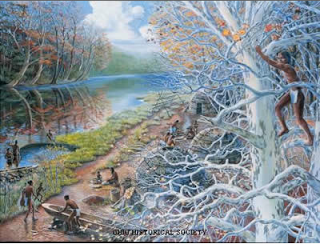 Painting from the Ancient Ohio art series
Painting from the Ancient Ohio art series depicting an Archaic base camp
along the Maumee River in northwest Ohio.
by: Susan A. Walton
Ohio's Moundbuilders pt.1
Introduction
Ohio's Archaic period was a time of transformation culturally, geographically, economically and socially for humans. As we learned in our previous posts, Native American lifestyles became more complex from 8000 BC–1000 BC.
The Woodland Period is a period of Native American Pre-Columbian history that lasted in the Eastern United States from 1000 BC to 1000 AD. The technological advancements that had begun in the Late Archaic Period, such as potter, continued to develop with each cultural group creating their own distinct art forms. What sets this period apart from the Archaic Period is the Pre-Columbian tribes greater dependence upon agriculture. Agriculture had been discovered during the Late Archaic Period. The discovery of agricultural revolutionized mankind's lifestyle and cultures. We will talk more about agriculture in a later post.
The Woodland Period is broken down into three time periods. Early Woodland (1000–1 BC), Middle Woodland (1–500 AD) and Late Woodland (500–1000 AD). The cultures who lived in the Eastern United States are also known as the Moundbuilders due to the many burial and ceremonial mounds that they constructed. Some of these mounds, such as Serpent Mound, are still visible today yet were more prominent when the white settlers came to the area during the 17-18th centuries. Farmers have destroyed many mounds throughout the centuries. Yet we know they did exist because explorers and surveyors mention the multitudes of mounds that scattered the landscape from Indiana to Florida. We also have archaeological records of the Moundbuilders.
Two cultures flourished in Ohio during the Woodland Period. These being:
800 BC-100 AD: The Adena Culture.
100 BC-400 AD: The Hopewell Culture.
Below is a map showing the locations of the Adena and Hopewell Cultures in relation to the Fort Ancient Culture. We will talk more about the Fort Ancient culture in another series, as they are relevant not only to Ohio Pre-Columbian history but to Shawnee culture as well.
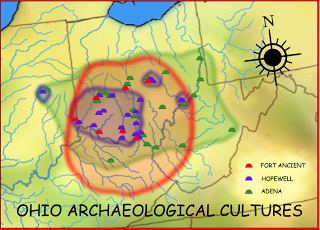
The Hopewell and Adena were not the only cultures in the Woodland Period but were prevalent in Ohio. The following map shows the location of some of these cultures in relation to the Ohio Hopewell Culture.

You can learn more about the Moundbuilders by watching this video.
Published on May 16, 2013 07:28
May 14, 2013
Ohio's Archaic Heritage: Burial Customs #NativeAmerican #Ohio
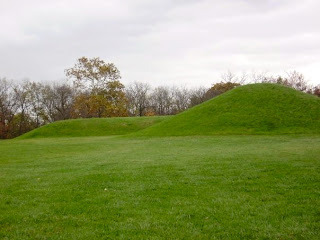 Burial Mounds by Allison BruningOhio's Archaic Heritage pt.4:Burial Customs
Burial Mounds by Allison BruningOhio's Archaic Heritage pt.4:Burial CustomsWelcome back to Ohio's Archaic Heritage. We have walked alongside our ancestors as they had to adapt to the climatic and geographical changes that beset upon them after the glaciers retreated back into Canada. As we learned in the previous posts, humans adapted quite well to their glacial free environment. They not only developed the atlatl and new hunting techniques but also began to settle down into a semi-sedentary lifestyle. Their sedentary lifestyle also lead to social changes that would remain a part of the Native American culture. These cultural changes included the adaptation of animal clans, participation in religious ceremonies, sacred objects, tribal affiliations, and a semi-nomadic lifestyle based on the seasons.
The change from a Paleoindian to Archaic lifestyle did not happen overnight but was a gradual transition that occurred from the Early Archaic period to the Late Archaic period. The first Archaic Native Americans to have dwelt on the Black River Watershed in Ohio arrived on Lake Erie's southern shore around 6,500 years ago. Known as Canesadooharie or River of Many Pearls by the Wyandot Nation, the Black River is a twelve mile long river in Northern Ohio whose mouth meets Lake Erie. It is considered part of Saint Lawrence Watershed and runs to the Atlantic Ocean via Lake Erie, Niagara River, and Lake Ontario. It was this group of Archaic Native Americans that were first to proficiently harvest roots, berries, tubers, leaves, and nuts. They were also the first group to cultivate squash. We will talk later about early cultivation.
Another group of Archaic Native Americans that is very well known in Ohio are the Glacial or Gravel
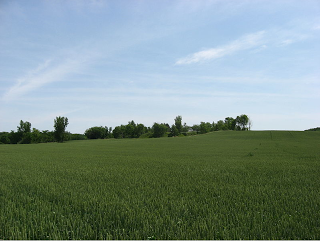 The Zimmerman Kame Site in Hardin County, Ohio
The Zimmerman Kame Site in Hardin County, OhioUS PUBLIC DOMAINKame Native Americans. The Glacial Kame Native Americans occupied Ohio between 8000 BC to 1000 BC. Archaeological records show this was a large tribe with villages spanning throughout southern Ontario, Michigan, Ohio and Indiana. The first Glacial Kame site discovered in Ohio occurred in 1856 near the village of Ridgeway in Hardin County, Ohio. The group was named Glacial Kame because they buried their dead in glacial kames, small hills of gravel, and sand deposited by glaciers. Archaeologists discovered Archaic 380 burials, which they removed from the site. Relics alongside the bodies included heavy copper beads, sole and saucer shaped ornaments of shell, masks made from skulls of wolves and bears and images of birds carved from hard slate. Hardin County has many Archaic Archaeological sites.
One of the most significant changes from Paleoindian to Archaic lifestyles was the burial of the dead. Every Archaic culture had developed their own scared rituals of burying their dead. Where the dead were buried was based on clan, family or social status. The Archaic people chose a specific site to bury their dead and would bring their dead to that site even if it meant it was miles away from where that person had died. Large cemeteries were established throughout Ohio and were used for extended period of time. For example, The University of Toledo archaeologists found 18 burial pits from the Williams site along the Maumee River that had been in use from 850 to 380 B.C. That's nearly 500 years! These cemeteries were often in the form of burial mounds. Burial mounds were constructed by the entire community. We will talk more about burial mounds in our next series: The Moundbuilders.
Published on May 14, 2013 15:56
May 9, 2013
#Dog Gone Wild: #NativeAmerican Dog Origins
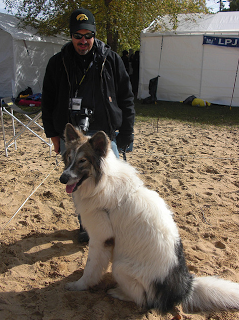 A Native American Dog
A Native American DogBy Aine D
@http://www.flickr.com/photos/dainec/4...
Dog Gone Wild:Native American Dog Origins
Welcome back! Today we are going to take a break from Ohio's Archaic Heritage to discuss one of the most important transformations in human history - the domestication of the dog.
The dog was the first animal humans domesticated. Mitochondrial DNA places the genetic split of the wolf and domesticated dog around 100,000 years but the oldest fossil record we have of this divergence is approximately 33,000-36,000 years ago. The domestication of dogs began in Eastern Asia and did not occur in North American. You can learn more about the domestication of the dog from this article. http://www.usfca.edu/fac-staff/dever/dog_evo.pdf
The Paleoindian had brought their domesticated dogs to North American when they cross over the Bering Strait. Just like today, the Paleoindians may have viewed their canine companion as a member of their family. The cohabitation of canine and humans offered many benefits to the Paleoindian such as protection, hunting companion, and a pack animal to pull their sled or travious. During the Pleistocene Epoch there were two wild wolf breeds that cohabited in North America. These being the Grey and Dire Wolves. You can learn more about these two breeds at http://hal_macgregor.tripod.com/kennel/wolves.html
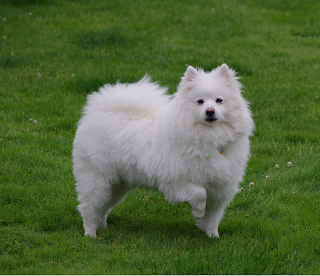 Izzy Posing (A North American Eskimo Dog)
Izzy Posing (A North American Eskimo Dog)by: Christmas K
@http://www.flickr.com/photos/christma... DNA studies show Paleoindian dogs and Euresia dogs share a common ancestry with the Eurasian Grey Wolf. There has been no evidence of a separate domestication of the North American Grey Wolf which proves that the domestication of the dog never occurred in North America but had already been achieved in Asia. Thus the domesticated dog came to North America with the Paleoindian.
Native Americans continued to inbreed their dogs instead of cross-contaminating the gene pool with
wolf DNA. This practice continued until they were introduced to European dog breeds in the late 17th to early 19th centuries. The Native American Dog slowly became extinct as it's DNA was mixed with the European DNA. The closest breed to resemble its Paleoindian ancestor in North America is the Eskimo Dog. Although its fur and vocalization is reminiscent of its wolf ancestor even the Eskimo Dog's DNA links it to the Australian Dingo, the New Guinea Singing dog, and the Shiba Inu.
The Native American Dog changed drastically after it came into contact with European dogs yet one thing remained the same, Native Americans still loved and appreciated their canine companions. You can read more about the Native American Dogs at: http://www.native-languages.org/dogs.htm and http://www.nytimes.com/books/first/s/schwartz-dog.html
Published on May 09, 2013 09:06
May 8, 2013
Ohio's Archaic Heritage: Archaic Settlements
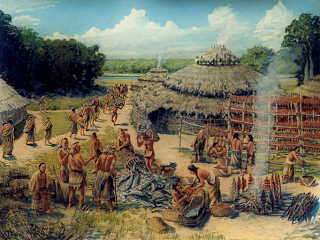 An Archaic Village
An Archaic Villagehttp://ancientlights.org/stoneworks.html
Ohio's Archaic Heritage pt3:
Archaic Settlements
Welcome back to Ohio's Prehistoric Heritage. What a journey we had endured so far. We began our walk through Prehistoric Ohio with the arrival of the Paleoindians. We learned that the Native Americans first dwelt in Southern Ohio because they could not go further north. Most of Ohio had been covered in glaciers. Once the glaciers retreated back into Canada, the prehistoric Native Americans began to explore the newly transformed Ohio. Mankind had to adapt when the mammoths and other large mammals went extinct. They developed new hunting techniques and weapons that granted them more freedom. These changes began at the start of the Archaic Period. Eventually the Paleoindians disappeared and the Archaic Culture thrived. The lifestyle changes did not happen overnight but had taken several decades for the new to replace the old.
Archaic Ohio
Although the Archaic Native Americans were highly mobile they did establish settlements. Each of the settlements are completely diverse based on the local resources. Ohio, during the Archaic Period, had four different geographic areas that each presented the prehistoric man with a wide range of diverse resources. These areas are seen in this graphic.
 With the transition from mobile to a more sedentary lifestyle, Archaic Native Americans developed their own unique cultures based on the area in which they had settled. Eventually, distinctive regional differences emerged. You can learn more about Archaic Geography of Ohio and Archaic Man at this link http://www.academia.edu/632282/The_Ohio_Archaic_A_Review
With the transition from mobile to a more sedentary lifestyle, Archaic Native Americans developed their own unique cultures based on the area in which they had settled. Eventually, distinctive regional differences emerged. You can learn more about Archaic Geography of Ohio and Archaic Man at this link http://www.academia.edu/632282/The_Ohio_Archaic_A_ReviewVillages and Camps
The Archaic people had two different types of camps that they used, larger villages and smaller hunting camps. Villages were established where there was a large food source. Depending on the region where these camps were established, the food source could be fish or nuts. According to archaeologists, Ohio was home to at least ten different distinct cultures through the Archaic Period. These cultures are identified in the graph below taken from The Ohio Archaic: A Review. The time period of their occupation is given on the left side of the graph while they are arranged underneath the region of Ohio in which they were located.
 Villages generally contained around 150 - 100 people at any given time. It was here that the Archaic people stayed the longest. Life was still nomadic in that family units moved with the seasons. During the winter, families would leave the village in smaller groups to dwell in rock shelters. These rock shelters were used year after year. The best rock shelters were those that were dry and faced the east. Early and Late smaller camps and rock shelters have been found throughout the state. Not everyone left the village during the winter. The elderly and others who could not travel during the winter often stayed behind in the village and ate from the preserved stock of food that had been gathered for them.
Villages generally contained around 150 - 100 people at any given time. It was here that the Archaic people stayed the longest. Life was still nomadic in that family units moved with the seasons. During the winter, families would leave the village in smaller groups to dwell in rock shelters. These rock shelters were used year after year. The best rock shelters were those that were dry and faced the east. Early and Late smaller camps and rock shelters have been found throughout the state. Not everyone left the village during the winter. The elderly and others who could not travel during the winter often stayed behind in the village and ate from the preserved stock of food that had been gathered for them.During the Spring, the family units would gather once again in the village. It was here they would supplement their diets with fish, berries, plants and nuts. Fishing required a team effort as the Archaic people used nets, spears, hooks on a line, and perhaps even poison to catch a large number of fish. Spring was the perfect season for the Archaic people to fish in because many types of fish swam up river in order to spawn.
Annual Spring gatherings were a joyous time in the village. Many social and ceremonial gatherings took place in the village.
Published on May 08, 2013 13:49
May 6, 2013
I won the #Liebster #Blog Award! #Iamwriting #Iamreading
And
 Goes toAllison Bruning!
Goes toAllison Bruning!Wow! I am so humble by this award. The Liebster Award is given to a blog that has less than 200 followers. Liebster in German means sweetest, nicest, kindest, dearest, beloved, kind, lovely, pleasant, valued, cute, endearing, and welcome. It is given to blogs that share those attributes. This is the third time I have received this award.
I want to thank Eleni Muller at http://philophrosyne-publishing.com for nominating me for this award. Eleni is an author from Hawaii and writes under the name of Eleni Papanou. You can read her Liebster Blog Award entry on her blog at http://philophrosyne-publishing.com/2013/04/11/liebster-blog-award-challenge/
Here are the rules:
1. Mention eleven random facts about yourself.
2. Answer the eleven questions that Eleni Muller asked me.
3. Find eleven people and do the same.
So here we go!
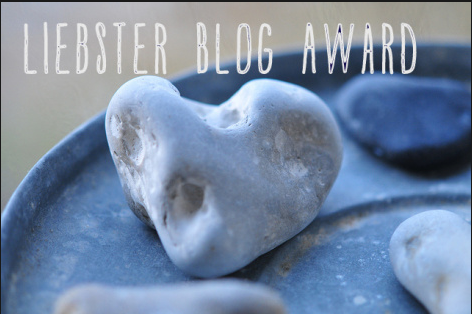
11 Random Facts About Allison Bruning
1) I once danced Ballet Folklorico de Mexico during college at Sul Ross State University.
2) I love Christian Contemporary Music concerts. I think I'm addicted to them.
3) I have two hometowns. Alpine, Texas and Marion, Ohio.
4) I am a self proclaimed choco-holic. The darker, the better.
5) I was adopted by a Delaware Native American woman who says I'm more of her sister then her own sister.
6) I went on my first archaeological dig when I was in Mount Vernon High School in Mt.Vernon, Ohio. I fell in love with archaeology that weekend and for the longest time I thought about pursuing it as a career.
7) I'm an expert in Native American culture, history and archaeology.
8) It's all about soccer with me. I played soccer from 1st through 10th grades and dreamed of playing professionally after high school.
9) I went on an RV trip with my grandparents and mother for my graduation present from Texas to Alaska.
10) I was adopted by a Mexican family when I taught school in Presidio, Texas.
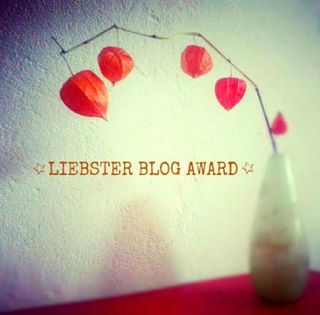
11 Random Questions from Eleni
1. What fictional character would you love to be for a day?
Laura Ingalls Wilder. I would love to live the life of a pioneer girl who saw the expansion of our country. Sometimes when we are travelling through Kentucky I try to imagine what life must have been like for the pioneers who crossed into the wilderness. I think in our minds we romanticize about like back then and don't realize just how hard life was. It was a different life where family and neighbors meant more than they do today.
2. What is the hardest aspect of writing for you?
Balancing the artistic and logical side in me. I tend to lean more towards art than structure yet I have learned the value of placing your story in an outline or paradigm before writing. Structure allows the writer more freedom because it doesn't allow for the story to run away on needless tangents or for you to chase plot bunnies needlessly down the rabbit holes of story destruction.
3. What three historical figures would you love to share a cup of coffee and conversation with?
Oh, easy!!!
A) Queen Elizabeth Tudor, the Pirate Queen. She fascinates me because she was so strong, wise and determined. She was ahead of her time.
B) William Shakespeare, the Bard. What isn't there to love about the man?
and
C) Laura Ingalls Wilder. Oh, to hear her stories.
4. If you weren't an author, what else would you be doing?
I'd be an archaeologist.
5. On you're deathbed, far into the future, how do you want to be remembered?
The woman who loved everyone and inspired others to chase after their dreams.
6. Do you believe in an afterlife?
Yes. I'm a born again Christian. I'm not religious.
7. What is your favorite book, movie, and album?
There's so many to choose from. Let's see.
Book - The Little House series, Inheritance Cycle, Twilight series, Harry Potter series and anything by Margaret George.
Movie - The Princess Bride
Album - Anything by Celtic Woman.
8. Name the worst aspect of humanity.
Our selfishness and greed.
9. Name the best aspect of humanity.
Our ability to love.
10. If an alien landed on Earth and asked you to go with him or her, but that you'd never be able to return home, would you go. Why or why not?
No, because I love my husband and dog. I would want them to come with me, too.
Can I sell my books there?
11. Do you believe intelligent life exists beyond this planet? Why or why not?
Yes, because I don't think the God would create so many planets without a purpose. Our universe is huge!
I nominate......
So here's the rules again.
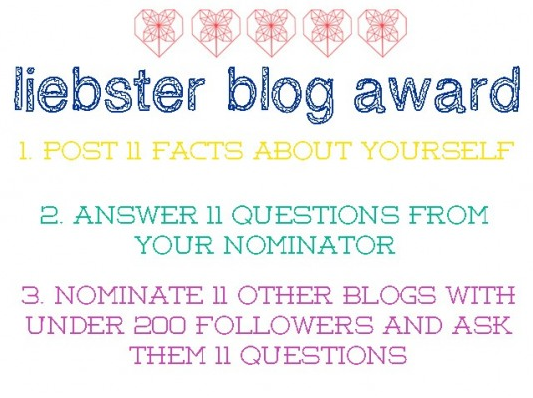 I nominate:
I nominate:1) Elizabeth Dela Rosa - www.elizabethdrosa.com
2) Ellie Mack - http://quotidiandose.wordpress.com/
3) Aurora Martinez - www.crimsonflowerreview.com
4) Jess Cox - www.raycorngrower.com
5) Stevan Richards - stevanrichards.thoughts.com
6) Aya Walksfar - http://ayawalksfar.com
7) Jacqueline Driggers - http://jdshare.blogspot.com/
8) Jesse Kaellis - http://www.jessekaellis.com
9) Angela Searles - www.angelasearles.blogspot.com
10) Veronica Cronin - croninandhanrahan@blogspot.com
11) Krystol Diggs - http://www.krystoldiggspublishing.com
And here is the official award my nominees can post it on their blog.
 Here's My 11 Questions for My Vict....Uhm, nominees. :-)
Here's My 11 Questions for My Vict....Uhm, nominees. :-)1) Whose your hero and why?
2) Why did you become an author?
3) Who or what inspires you?
4) If you could encourage your fans with one phrase, what would that phrase be?
5) What is your favorite genre to read? Why?
6) What is your favorite genre to write? Why?
7) If you could be any superhero for a day who would you want to be and why?
8) Quick: Favorite Ice Cream Flavor
9) Quick: Favorite Candy Bar
10) You have only ten seconds to save an item in your burning house. What do you take and why?
11) Who is the greatest figure to have ever lived and why?
Published on May 06, 2013 09:01
May 2, 2013
Ohio's Archaic Heritage: Stone Tools #history #nativeamerican
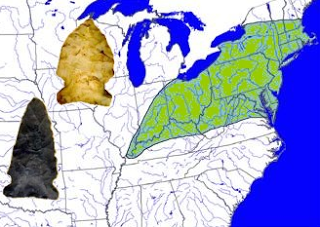 Ohio's Archaic HeritagePt. 2Knives, Points, Axes and Scrapers
Ohio's Archaic HeritagePt. 2Knives, Points, Axes and ScrapersThe Archaic Period is divided up into three stages. These are: Early (8000B.C.E. - 6000 B.C.E.), Middle (6000 B.C.E. -3500 B.C.E.), and Late (4000 B.C.E. -1500 B.C.E.). Sometimes historians and scientists will add a Terminal Stage between (1500 B.C.E.–700 C.E.) This end stage overlaps the Woodland Period. We will be talking about this period in our next series. Early Archaic life resembled a Paleoindian culture as small groups continued to life the Paleoindian nomadic lifestyle. It isn't until the Middle Archaic Period where some of these groups start to develop a more sedetary lifestyle. The change from nomadic to sedentary did not happen all at once nor was it across the board. This change was gradual and varied from group to group, as did the acceptance of the atlatl.
The Archaic people created knifes, spearheads, scrapers and other tools out of ground stone. They rarely threw their tools away when they became worn. Instead they would reshape the item into something else. The transition from Paleoindian to Archaic was a gradual procession that occurred as the large mammals became extinct and the climate became warmer. As we learned in our last post, the Archaic hunters had to change their hunting methods in order to survive.
Archaic tool kits reflect the change in hunting techniques as they now contain a wide range of ground stone tools that include celts and axes used to cut and work trees, grooved rounded stones to weight fishing nets, spear points, knives, a variety of scrapers, as well as tools and ornaments made of bone, antler, and shell. Another distinction between the Paleoindian and Archaic cultures were their spear points. This was due to the discovery of the atlatl.
Axes, Chisel, Gouges and Adzels
The transition to a sedentary life required that the Archaic to develop new tools that would allow them to work with wood. Woodworking was important for the Archaic people because it allowed them the ability to create shelters, canoes and other daily used items.
The flint they had been using to create their points, drills and other tools was not suitable for woodworking because flint shatters when it hits something hard. The Archaic people used other stones to create their axes, chisels, gouges and adzels. Just like the skilled huntsman, an expert craftsmen was highly valued by his people.
Stone axes were very effective on wood as seen by this video.
Three dugout canoes have been found in different parts of Savannah Lake, Ashland County, Ohio. One of these canoes, dating to 1600 B.C., is 20 feet in length. Savannah Lake is located between the Lake Erie and Ohio River watersheds. This find proves that the Archaic people were using the waterways for travel purposes. The Archaic people fished more than they hunted game so it would make sense for their settlements and activity to be located close to waterways.
Points
The change from a Paleoindian point to an Archaic point did not happen overnight. Archaeologists have identified several "transitional points" that were used in the Archaic Period as the Archaic people began to transition out of their Paleoindian lifestyle.
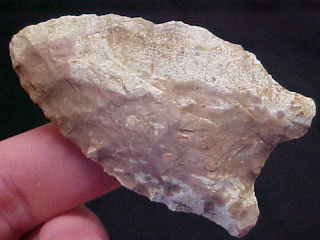 A Paleoindian Spearhead found in Ohio
A Paleoindian Spearhead found in OhioThe images below are of Archaic points that were found at the Falls of Ohio State Park in Indiana. This park sits on the banks of the Ohio River. Many points can be found along the Ohio River. Notice the different sizes and shapes of each spearhead and the progression in time.
 Archaic Points
Archaic Pointshttp://www.fallsoftheohio.org/Fallsof... most famous of all Ohio Archaic Points is a fine example of the Archaic people's resourcefulness.
Known as the Ohio Dovetail, settlers discovered these dovetailed shaped points while plowing their fields. The Ohio Dovetail took on many shapes and sizes. They were usually worn out knives that were reshaped into a spearhead. They are so numerous that they are still being found today. The picture below shows an Ohio Dovetail that was found in Licking County and is currently being sold on EBAY.
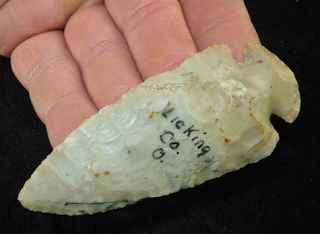 An Ohio Dovepoint
An Ohio Dovepoint Unfortunately many stool tools and points find their way into the market instead of being preserved so everyone can enjoy a piece of cultural history.
Published on May 02, 2013 07:37
April 30, 2013
Ohio's Archaic Heritage: Atlatl and Bannerstones #NativeAmerican #Ohio #History
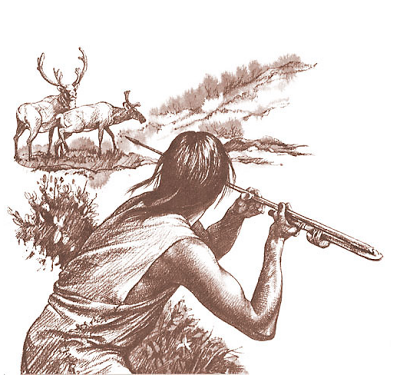 Archaic Indian Hunting with Atlatl
Archaic Indian Hunting with Atlatl @ http://bit.ly/12XlH5u
Ohio's Archaic Heritage
Pt 1:Atlatl and Bannerstones
Ohio's Paleoindian Cultures flourished in the region as the glaciers dramatically changed the landscape around them. The glacial carving of Ohio's landscape had not happened overnight. The Northern state had been covered by glaciers three times in prehistoric times, making much of the land inhabitable. You can see a glacial map of Ohio and how each of the three glaciers remained in Ohio at this http://www.dnr.state.oh.us/portals/10/pdf/glacial.pdf
Ohio's Paleoindian culture disappeared from Ohio around the same time as the Archaic Culture emerges. The Archaic Culture inhabited Ohio from 8,000 B.C to 500 B.C. The Paleoindian lifestyle had depended upon the cold, harsh glacial climate much as the Eskimo's lifestyle depends upon the harsh surroundings they live in today. When the last glacier retreated back into Canada it not only left a new different landscape but a climate change as well. Over the years, the climate became warmer and thicker. Thick forests grew throughout the region. The Mastodons, Mammoths and other large mammals the Paleoindians had depended upon for food had been driven to extinction by over hunting and the climate change by 12,700 years ago. With the loss of their food source, a climate change and a new landscape the Paloindian way of life could no longer sustain the people.
During the beginning of the Archaic Period the Archaic Culture resembled their Paleoindian ancestors as they continued to be nomadic. With the extinction of the larger mammals, the Archaic people depended upon smaller game, such as deer and rabbits, for food. They also fished in lakes and streams, and gathered berries and nuts to supplement their diet.
Hunting techniques and technology changed in order to for the shift from larger mammal to smaller mammal hunts. During the Paleoindian Period hunting was a group effort due to the size of the prey. Smaller game hunts meant that a man could hunt on his own. He also had a new weapon - the atlatl.
Although this video compares the atlatl with a bow and arrows, the bow and arrow would not be invented in North America until 2,000 years ago. Europeans had been using the atlatl from more than 30,000 years ago but the weapon was not discovered in North America until 12,000 years ago.
The atlatl revolutionized the way humans hunted and went to war. It allowed the warrior/hunter to throw their spear much farther than ever before. You can read more about the weapon by visiting this link http://www.hollowtop.com/atlatlbob.htm.
An artifact most commonly found in Ohio that may have been used with the atlatl is a bannerstone. The
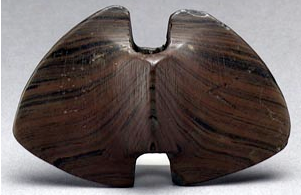 A Bannerstone found in Ohio.
A Bannerstone found in Ohio.US Public Domain bannerstone is a symmetrically carved ground stone with a hole drilled in the center. They are found in all shapes and sizes, including some that are butterfly shaped such as the one pictured. There are many debates as to what the bannerstones were used for. Some believe they were used as ceremonial pieces or weights while other contest the bannerstone was used for drilling, cordage making, or fire making. Robert S. Berg and William S. Webb believe the bannerstone was part of the atlatl or was used to repair it.
Authors Richard R. Townsend and Robert V. Sharp of Hero, Hawk, and Open Hand: American Indian Art of the Ancient Midwest and South stated in their book "“[bannerstones’] craftsmanship and materials suggest that they also served as emblems of prestige and status conferred upon hunters coming of age, and as supernatural talismans for increasing the spear-throwers efficacy. They may also have served as emblems of clans or other social units”.
Join me Thursday as we take an inside look into an Archaic Period village.
Published on April 30, 2013 08:14
April 25, 2013
Ohio's Paleoindians #history #ohio #NativeAmerican
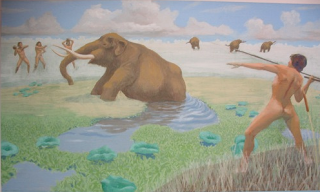 Paynes Prarie Preserve State Park
Paynes Prarie Preserve State ParkBy: ryan griffis @http://www.flickr.com/photos/grifray/...
Life in Ohio's Pleistocene
A few weeks ago I had presented to you a blog posting concerning the first inhabitents of Ohio. These Native Americans were known as Paleoindians. The Paleoindian Period of history lasted between 13,000 -7,000 B.C. The earliest evidence of human occupation in Ohio dates to 13,000 B.C. Ohio's Paleoindian period overlaps with the introduction of the Archaic Native Americans arriving in Ohio around 8,000 B.C. Scientist had hypothesis that the Younger Dryas impact may have eliminated the paleoindians yet this is still being researched. You can read more about it at http://en.wikipedia.org/wiki/Younger_Dryas_event Whatever the cause may have been for the destruction of the Paleoindians in Ohio there is no archeaological evidence to support their existence in Ohio past 7,000 B.C.
Ohio during the Paleolitic Period was different than the Ohio we know today. Lake Erie and the Ohio
River did not exist before the glaciers came to Ohio. Instead Ohio had one major river, The Teays River. You can learn more about Ohio's Ancient Nile River at http://www.dnr.state.oh.us/parks/magazinehome/magazine/sprsum04/teaysriver/tabid/364/Default.aspx
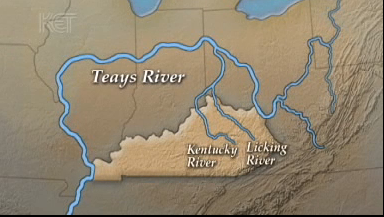 Map of Landscape Before the Paleoindian Period
Map of Landscape Before the Paleoindian PeriodKET Television
http://www.teachersdomain.org/asset/k...
This video is from the Kentucky Educational Television and shows how the glaciers formed the Ohio River. http://www.teachersdomain.org/asset/ket08_vid_ohioriver/
Thirteen thousand years ago, the northern part of the state was completely covered by a glacier. Only 1/3 of the state was free from ice. It was very cold and moist. This slowly began to change as the glaciers retreated. The glaciers formed the Great Lakes.
Between 10,000 to 9,000 B.C, the northwestern portion of Ohio was covered by clumps of dwarf willow growing aling the river banks. There were many small groves of spruce, pine, aspen, and fir trees separated by open ground. Mastodons, mammoths, elk, caribou, deer, giant beaver and caribou lived in this region. The Paleoindian hunters would often hunt in this region in order to provide for their families. Although several prehistoric animals and Paleoindian points have been found throughout Ohio there has never been a Paleoindian point found with the remains of the animals dated to the Paleoindian Period. The Paleoindians favored hunting Caribou and possibly hunted them using the same methodology that current Eskimo groups in Alaska use today. If we study the Eskimos and their hunting methods we may have a glimpse into how the Paleoindians hunted in Ohio so long ago. You can learn more about the Paleoindian hunting patterns here http://ohsweb.ohiohistory.org/gallery2/main.php?g2_itemId=1200
Ohio's Paleoindians may have been living in the southeastern portion of Ohio as early as 17,000 B.C. The land above the Southeastern portion of Ohio was slowly exposed as the glaciers retreated throughout the Paleoindian Period. The Ohio River and the Great Lakes never existed before the glaciers came. The Paleoindians lived during a time where the land was being slowly and dramatically changed. Paleoindians had to live on the high ground or in caves in order to avoid the flooded valleys that the glaciers left behind as they retreated. Southeastren Ohio was a safe place for the Paleoindians to live since it had not been exposed to glaciers. Here the land was covered with oak, walnut, and hickory trees along the hillsides. The nuts were gathered by the Paleoindians and used as a supplement to their diets.
Although archeologists have never found the skeletal remains of a Paleoindian they can hypothesis what their life may have been like through archeaological records. The Ohio Paleoindians used flint that they found in river beds to make their points. Archeologists have found Paleoindian quarries and workshops along the Walhonding River in Coshocton County.
You can learn more about Ohio's Paleoindians at
http://ohsweb.ohiohistory.org/gallery2/main.php?g2_itemId=40&g2_page=2
Published on April 25, 2013 10:48
April 23, 2013
A Little House Memory
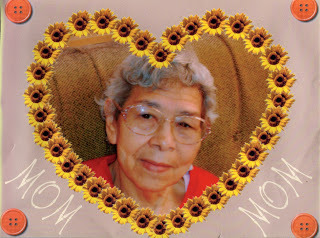 In Honor My Mother-In-Law
Elida Espinosa
In Honor My Mother-In-Law
Elida Espinosa
I haven't had a chance to write for a week due to a family emergency. Last weekend my husband and I learned his mother was in the CCU unit at the Medical Center Hospital in Odessa, Texas. We left Kentucky soon after we heard the news. I drove 11 hours to Oklahoma where we stayed the night then drove another 7 hours the next day until we reached Odessa. Mom died four days later in the Hospice House. My mother-in-law's death was not a natural occurrence and there is a criminal investigation going on concerning her suspicious death. My husband and I couldn't mourn for his mother's passing because we knew it wasn't her time to die and that her death had been caused at the hand of another. I used to hear family members of murder victims say that they are progressing in life but are so tired. I never understood what that meant until this happened to my husband and I. Life must go on and my mother-in-law would want her son and I to have a good life.
My mother-in-law was a sweet, very loving woman who wanted only the best for her four children. She had been raised by her grandparents. Her husband, Socorro, had passed five years earlier. He had been a ranch hand and migrant worker. Mom had worked as a migrant worker before she had children. After her eldest daughter was born she settled down in her husband's aunt's house and he went to work as a ranch hand. Her little family grew from her aunt, husband and Lupe to a family of six with the addition of my husband and his older brother, Roberto. Mom's father bought her a house next door and her family left her husband's aunt's house to live in their new home. Except her eldest daughter, Lupe, stayed behind to live with Aunt Manuela. Manuela had lost a child and her husband long ago. Mom felt sad for her husband aunt and said she could raise her eldest daughter. But dad didn't like the arrangement. Nevertheless, dad's aunt raised Lupe but Lupe never forgot her parents. A few years later mom had a daughter and named her Carmen.
Mom loved to watch the Little House on the Prairie series when it showed during the 70's. My husband and I decided the best way to honor mom was to visit the Little House on the Prairie site outside of Independence, Kansas. My husband and I arrived at the site in time to enjoy a picnic lunch in the same prairie where the real Laura Ingalls Wilder had ran and played with her sister, Mary. It was sereal to think that the character in the books and on the TV show was a real person. A little girl who could have well stood in the same place where we ate our lunch. I always knew that Laura was a real person. She had been one of my favorite authors who influenced my writing career when I was a child.
Charles Philip (Pa) and Caroline Lake Quiner Ingalls (Ma) arrived in Kansas with five year old Mary Amelia Ingalls and three year old Laura Elizabeth Ingalls in 1869. They had arrived on the Kansas plains with other settlers who thought the land was open for settlement. The small family lived in their one room cabin for little over a year. It was during this time that the family had contracted an ailment that would have killed them had not Dr. Tann stumbled upon the family. Dr. Tann was a black doctor that Laura mentions in her book. It is also at this Little House where the family meets Mr. Edwards. Mr. Edwards is actually Edmund Mason. Both Dr. Tann and Edmund Mason are buried in Independence, Kansas but in different cemetaries. Another major event for the Little House family occurred on this site as well. It was here that Caroline Celestia Ingalls (Carrie) was born.
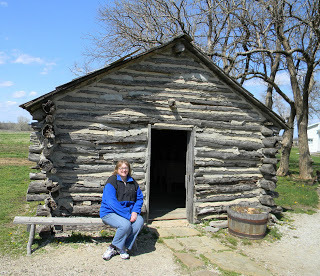 Allison sitting outside the Little House on the Prarie.Laura described the prairie in her Little House on the Prairie book "as far as they could see, to the east and to the south and to the west, nothing was moving on all the vastness of the High Prairie. Only the green grass was rippling in the wind, and white clouds drifted in the high, clear sky." The land was paradise for the little family. But it would not remain so for long.
Allison sitting outside the Little House on the Prarie.Laura described the prairie in her Little House on the Prairie book "as far as they could see, to the east and to the south and to the west, nothing was moving on all the vastness of the High Prairie. Only the green grass was rippling in the wind, and white clouds drifted in the high, clear sky." The land was paradise for the little family. But it would not remain so for long.Little did Pa know but the land he had chosen to settle on was part of the Osage Diminished Reserve. The Osage Diminished Reserve had been land the United States Government had set aside for the Osage Nation to use. The Osage Nation had migrated into the Kansas area during the 17th century. The Osage had been one of their hunting trips when the settlers, along with the Ingalls, had decided to settle on their lands. The Osage Nation was constantly at war with the settlers. Laura was accustomed to seeing the Native Americans. In 1870, the United States Government bought the Osage Diminished Reserve from the Osage Nation but since Pa and other settlers had not filed a claim for their lands they were told they would have to leave or the US Army would force them to leave. Pa packed up his little family and headed back to Pepin, Wisconsin. It was easy for Pa to find a place to live in Wisconsin. He had sold his farm three years earlier but the gentlemen who had bought it had never paid Pa for the transaction. Pa reclaimed his farm and cabin where he lived with his little family until 1874.
Published on April 23, 2013 15:04
April 10, 2013
The #Bestselling #NativeAmerican Historical Fiction Book Is Back!
She's About To Face The Storm o f Her Life

Newly released from Mountain Springs House Publishing
In the harsh northwestern frontier of Ohio and Kentucky, a prophecy has been told. A man whose heart appears pure shall deceive her. The power he holds over her will lead her to evil. She shall denounce the ways of Our Grandmother. Another man comes, whose pure heart beats for her alone, and who has a pure spirit devoted to the goddess, Our Grandmother. He shall defeat the evil and set her free.
Calico Marie Turner, a white woman raised by the Shawnee and destined to become a great medicine woman, must trust the one man who hates her the most. How can she trust Chief Little Owl Quick as the Wind to save her from his best friend and village shaman, Hunting Bear?
Calico (Children of the Shawnee series: Book 1)By: Allison Bruning
Get you copy on Amazon at http://amzn.to/ZfL1z8
Also available on Smashwords.
https://www.smashwords.com/books/view/301789
Published on April 10, 2013 12:09



